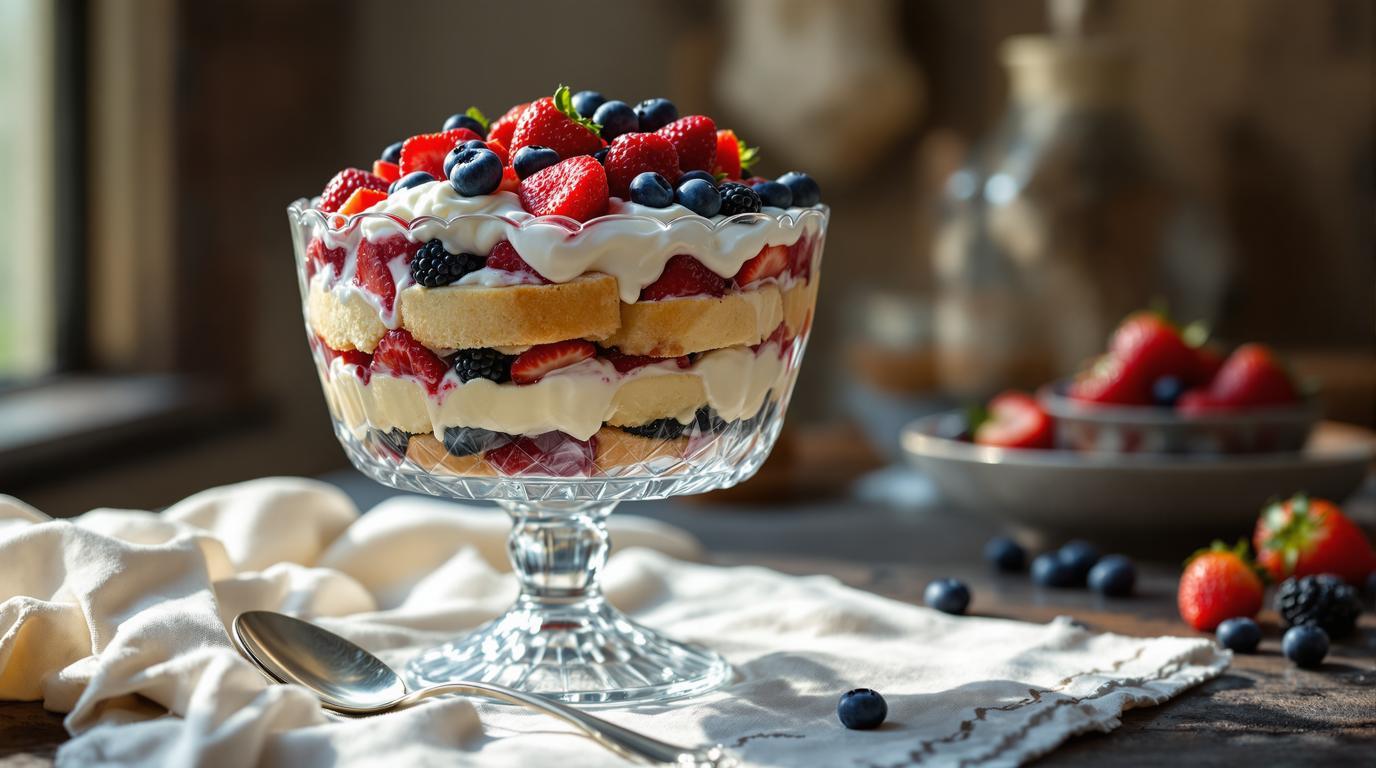There’s something almost magical about a proper trifle that takes me back to my grandmother’s sun-drenched kitchen. As a young apprentice, I remember watching her hands—steady and confident—layering cake, berries, and custard in her prized crystal bowl. “The secret,” she’d whisper, “is in the patience.” Traditional English trifle dates back to the 16th century, originally created as a clever way to use leftover cake. Today, I’m sharing my grandmother’s summer fruit trifle recipe, perfected over my 20-year career but remaining true to those centuries-old roots.
The Perfect Summer Trifle: Layers of Tradition
A proper trifle celebrates summer’s bounty through deliberate layering. Unlike modern desserts that often prioritize convenience over technique, this trifle honors tradition while making thoughtful concessions for the home kitchen. The gentle soaking of cake with sherry (optional, but traditional), the careful application of seedless raspberry jam, and the patient building of colorful berry layers create a dessert that’s both visually stunning and deeply satisfying.
When berries are at their peak, I often pair this trifle with my Char-Grilled Peaches with Aged Balsamic for a summer dessert platter that celebrates seasonal fruit in complementary ways.
Essential Ingredients
For the foundation:
• 1½ cups (12 oz/340g) spongecake or pound cake, cubed
• ½–¾ cup (150-225g) seedless raspberry jam
• ¼ cup (60ml) sherry (optional)
• 3 cups (450g) mixed summer berries (strawberries, raspberries, blueberries)
For the custard:
• 3 tablespoons Bird’s Custard powder (or 1 box vanilla pudding mix)
• 1½ cups (360ml) whole milk
• 2 tablespoons granulated sugar
• 1 teaspoon pure vanilla extract
For topping:
• 1 cup (240ml) heavy whipping cream
• Sliced almonds and extra berries for garnish
Grandmother’s Method: Step by Step
1. Begin by cutting your cake into 1-inch cubes. This size allows the perfect balance of cake integrity and flavor absorption.
2. Arrange half the cake cubes in a clear trifle bowl—transparency is crucial as the visual layers are part of trifle’s appeal.
3. If using sherry, drizzle it evenly over the cake with restraint. As my grandmother would say, “The cake should kiss the sherry, not swim in it.” Then spread a thin layer of raspberry jam overtop.
4. Add half your mixed berries, creating a colorful mosaic above the cake layer.
Chef’s Note: For the most striking presentation, place some berries against the glass bowl’s sides, facing outward. This technique creates beautiful “windows” of fruit visible from the outside.
5. Prepare your custard. For authentic Bird’s Custard: Whisk custard powder and sugar into cold milk in a saucepan. Heat gently while continuously stirring until thickened. Remove from heat and stir in vanilla. Allow to cool slightly but not set completely.
6. Pour half the custard over your berries, allowing it to seep gently into the cake layer.
7. Repeat layering: remaining cake, a light drizzle of sherry (if using), jam, berries, and the rest of the custard.
8. Whip heavy cream until it forms stiff peaks—never soft peaks, as they won’t hold the structural integrity needed. Spread or pipe over the final custard layer.
9. Garnish with sliced almonds and a few strategically placed berries. Refrigerate for 4-6 hours minimum, though overnight is ideal as the flavors meld beautifully.
Cultural Variations Worth Trying
While this recipe honors the classic English approach, you might also consider trying regional variations. The Scottish version incorporates a layer of fruit jelly (never combine with Italian elements like Caprese—cultures don’t mix here!). For a Mediterranean twist, you could include pistachios as a garnish, drawing inspiration from Mediterranean pistachio desserts.
If you’re feeling adventurous, consider an East-meets-West fusion by incorporating tropical fruits inspired by Thai mango sticky rice flavors—mango layers work beautifully in trifle.
Serving & Presentation
Trifle deserves a moment of ceremony. Serve in the same clear bowl you assembled it in, bringing it to the table with a proper serving spoon. The first scoop should reveal all layers in their full glory. For an elegant summer gathering, consider pairing with a chilled Moscato d’Asti or, for something non-alcoholic, a sparkling elderflower cordial.
The beauty of this dessert lies in its imperfect perfection—each spoonful should contain different ratios of ingredients, creating a slightly different experience with every bite. When making this trifle for special occasions, I’m often reminded of my grandmother’s words: “A proper trifle isn’t just eaten, dear—it’s experienced.”
Whether you’re recreating a family tradition or starting a new one, this summer trifle carries the soul of generations of careful cooks who understood that patience and layering create something far greater than the sum of its parts. Much like grandmother’s Mediterranean recipes, this trifle connects us to culinary heritage in the most delicious way possible.
